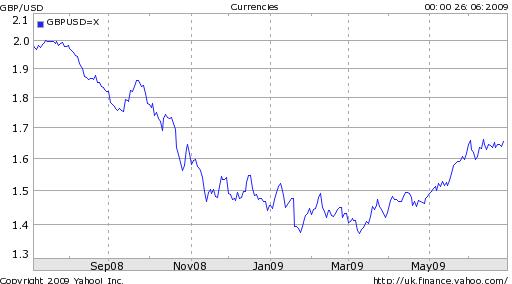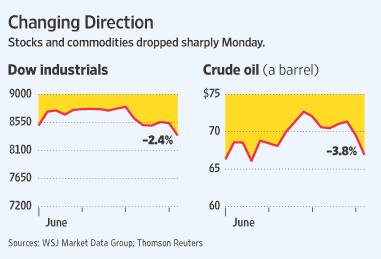It’s difficult to ignore that some green shoots are taking root. We may have seen the absolute bottom of the equity markets, but a steep incline is not sustainable, nor is a ‘v’ shaped growth graph. Reality and gut feeling tells us that we need to dredge along the bottom for a period of time before true growth can become sustainable. Perhaps we will get a rude awaking this coming Friday with NFP. There are whispers of a -200k print. Consensus has us at -375k with a +9.6% unemployment rate. Euphoria is always welcome, but the crash from the highs takes a lot of getting use to. Markets are flush with cash and after 5-months of a steep incline, many question ‘have they missed the boat’? Hardly, ‘the less bad is worse’ has occurred because of deep costing cutting and personal sacrifices. This quarter we get to see if it’s sustainable. All we are searching for is the true inherent value! And with US households with less cash to spend, it’s got to be lower not higher…
The US$ is weaker in the O/N trading session. Currently it is lower against 9 of the 16 most actively traded currencies in a ‘subdued’ illiquid O/N session.

Yesterday’s data confirms that the US consumer subtracted from last Q’s GDP growth. To fully understand one must look beyond the ‘nominal’ headline and focus on the ‘inflation’ adjusted print. In reality the consumer remains a drag on the US economy! In ‘Real’ terms spending was down in Mar., April, and June and flat in May. In total, spending was down -1.2% annualized for the Q (2/3’s of the economy remains in defense mode). According to analysts, the 1st Q rise was an anomaly vs. the yearly pattern of declines despite all the Government stimulus packages. Digging deeper, nominal-personal spending advanced in June (+0.4%, m/m) because of the surprising gains in non-durable goods, as durable goods expenditure fell -0.2%. Nominal-personal income fell -1.3% after 2-months of gains. Weakness was reported across most of the sub-categories. It’s worth noting that Government wages and salaries continued to rise despite the private sector depreciation. Social benefits fell -6%, m/m (1st decline in 10-months), despite UI rising in the month. With the ongoing pressures of the private sector wages, one can expect collection of personal taxes to also fall (less income for the Government). It’s fair to say that personal income will deteriorate further or best, remain static! The Core-PCE index (the Fed’s go-to inflation indicator) advanced in line with expectation (+0.2%), indicating that inflation remains well behaved.
US housing is doing its bit to contribute to the ‘green shoot’ theory. Yesterday, pending home sales of existing homes surged last month (+3.6% vs. +0.8%), this was the 5th-consecutive increase and exceed all analysts’ expectations. The main reason, lower prices continued to be backed up by low mortgage rates!
The USD$ currently is lower against the EUR +0.03%, JPY +0.28% and higher against GBP -0.06% and CHF -0.06%. The commodity currencies are weaker this morning, CAD -0.12% and AUD -0.32%. Yesterday was a time to reflect, the loonie treaded water in the morning session after its aggressive gains across the board this week. The greenback has managed to print new yearly lows and by default, apart from the MXN, most currencies have strengthened against the buck. The world covets commodity currencies as risk appetite increases and green shoots root. For the loonie per-se, nothing has changed, the currency managed to print its strongest level in 10-months yesterday. Last month it was the biggest G10 winner vs. the greenback, and this month like all its commodity traded cousins, it’s starting off on the same foot. This on-again, off-again recession is bringing risk takers back into the market. With US corporate earning’s beating expectations, this has prompted investors to seek riskier assets such as stocks and commodity-linked currency’s. By default, higher yielding assets like the loonie do much better. The strength of the currency continues to get ahead of fundamentals. Even the Finance Minister Flaherty said ‘there are some steps that could be taken to dampen it’. This would imply some kind of intervention in the market to weaken the CAD. This week we get to see North America’s employment numbers. Are we in for more surprises? Let’s see if the domestics want to cash in on the recent surge this morning and sell their own currency or are they about to take on the BOC?
Earlier this week the RBA kept O/N borrowing costs on hold for a 4th-consecutive month (+3.0%). Governor Stevens said that the Australian economy is stronger than their original predictions a few month’s ago, ‘with both consumer spending and exports notable for their resilience’. Last week Stevens indicated they may not wait for unemployment to peak before hiking rates again. This has heightened speculation that Australia will increase borrowing costs faster than most other nations. After touching its highs, its strongest level vs. the greenback in 11-months, the currency has managed to pare some of the gains after the RBA comments and Asian equities are off their highs (0.8424).
Crude is lower in the O/N session ($71.04 down -38c). It’s not surprising to see crude pare some of its 13% gains over the past 3-trading session. The fear of over extending the euphoric nature is just. Demand destruction remains intact, and there are no fundamental reasons to suggest otherwise at this point. Analysts are expecting another weekly gain in this morning’s EIA report. Reality tells us that inventories are high, demand is still really weak and the risk is increasing that we will see a bigger correction towards $60. We tried last week briefly, but the ‘Bulls’ went on a rampage, pushing prices briefly over the $72 a barrel on Monday. This was the 1st time in over a month and all of this on the back of stronger US fundamental data. Even gas prices surged, as increasing US industrial activity has boosted optimism and swayed investors that fuel consumption will rebound. This is a tall order on the back of recent crude fundamentals, where we continue to experience healthy ‘demand destruction’. The recent appreciation of the black-stuffs prices has been too rapid. There is no denying that with growth comes a commodity price increase. We are not seeing growth, but indicators are showing us a ‘less bad is good’ scenario. Investors are getting ahead of themselves. One of the major factors has been the amount of cash that has been left idle in this downturn. Money managers are aggressively trying to put some of it to work. It’s worth noting that OPEC increased their output levels for a 4th consecutive month in July (agreed compliance is slipping as some members states take advantage of the stronger prices).Their output averaged +28.39m barrels a day (up +45k, m/m). The key to this recent rally will be the US economy ability to continue this pick up or if it limps along! Last week crude prices plummeted on the back of a staggering surprise in the weekly EIA inventory numbers. They reported a whopping +5.1m barrel increase to +347.2m, w/w. The market had anticipated an average decline of -1.2m barrels. Refiners cut operations by -1.2% to +84.6%, relative to capacity, while imports climbed +8.9% to +10m barrels a day last week (the highest since Jan.). Gold prices are following other commodities, the yellow metal advanced to a new 2-month high as the greenback faltered, printing 10-month lows and equities climbed, thus boosting the appeal of the commodity as an alternative investment ($967).
The Nikkei closed at 10,252 down -122. The DAX index in Europe was at 5,418 up +2; the FTSE (UK) currently is 4,673 up +3. The early call for the open of key US indices is lower. The 10-year Treasury’s backed up 5bp yesterday (3.68%) and is little changed in the O/N session. Despite the plethora of US product last week (a record $150b), treasuries managed to grind higher. But yesterday we witnessed a 2nd-consecutive day of price declines as pending sales of existing homes in the US advanced more than forecasted last month. This is further evidence that the deepest US recession in 50-years is easing. On Monday, Treasuries prices declined the most in more than 2-months, as reports on manufacturing and construction spending topped analyst’s original estimates. Recent US data suggests that the 2nd Q may prove to be the final ‘negative’ US GDP number. If true, there is no reason to see lower yields in the short term. This Friday’s North American employment reports could provide some support for the freefalling FI asset class!





